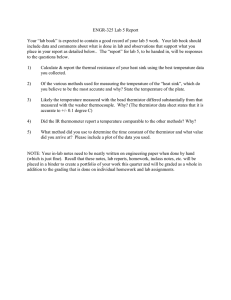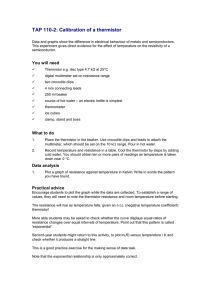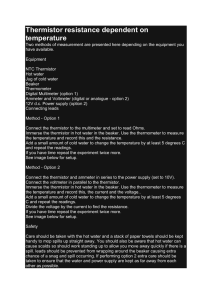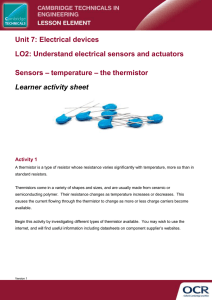Sensors - temperature - the thermistor Lesson Element
advertisement
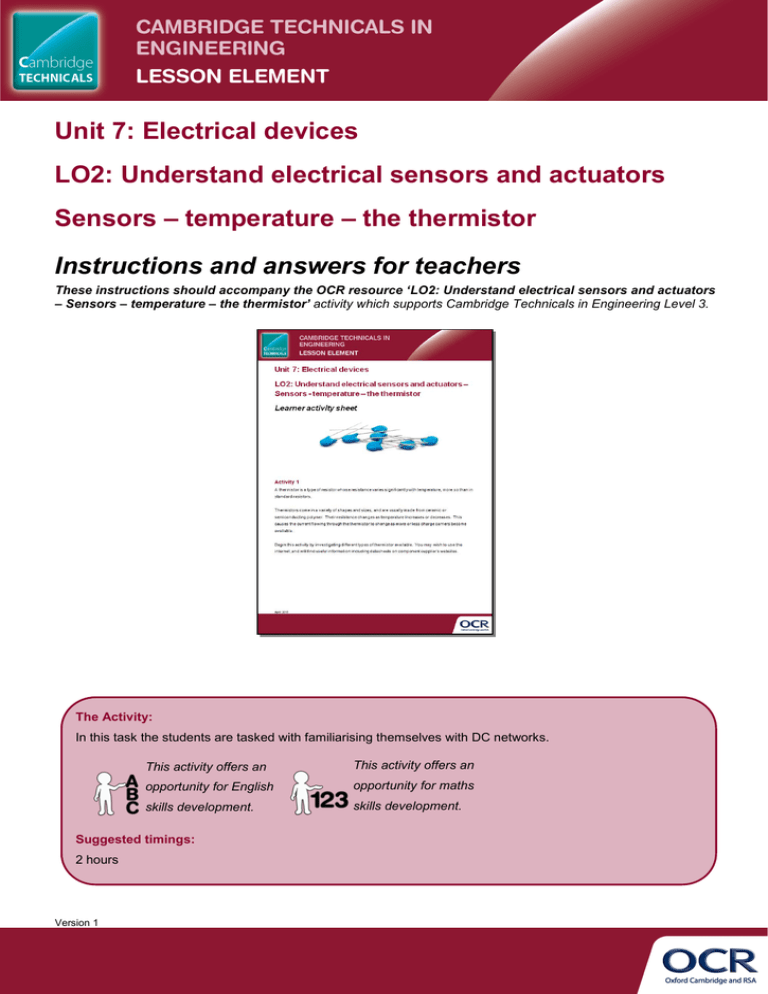
Unit 7: Electrical devices LO2: Understand electrical sensors and actuators Sensors – temperature – the thermistor Instructions and answers for teachers These instructions should accompany the OCR resource ‘LO2: Understand electrical sensors and actuators – Sensors – temperature – the thermistor’ activity which supports Cambridge Technicals in Engineering Level 3. The Activity: In this task the students are tasked with familiarising themselves with DC networks. This activity offers an This activity offers an opportunity for English opportunity for maths skills development. skills development. Suggested timings: 2 hours Version 1 Activity 1 For Activity 1 learners have been tasked to investigate the thermistor before performing an experiment using it. A thermistor is a type of resistor whose resistance varies significantly with temperature, more so than in standard resistors. Learners may use the internet or other sources of material to complete their investigation. Manufacturer data sheets might also prove a useful source of information. Answers to questions: 1. What is a NTC thermistor and how does it work? The NTC thermistor has a negative temperature coefficient – meaning that the resistance of the device decreases as the temperature is raised. The thermistor consists of semiconductor material in which the amount of active charge carriers increases as the temperature is raised. For the NTC type of thermistor, the device is manufactured in order to have an approximately linear relationship between resistance and temperature over part of its operating range. 2. What is a PTC thermistor and how does it work? The PTC thermistor works on a similar principle to the NTC type – except that the resistance of the device increases as temperature rises. The PTC type is often termed the ‘switching’ type of thermistor meaning that their resistance suddenly increases at some critical temperature. However, some PTC thermistors with a linear ‘resistance vs. temperature’ characteristic do exist. 3. What applications are thermistors used for? Typical applications of the thermistor include: • Temperature control (as a temperature sensor) • Circuit protection • As an input sensor Version 1 Activity 2 For Activity 2 learners are required to perform an experiment using a thermistor and hot water in order to determine its characteristics. Teachers should select a suitable thermistor of the NTC type. The equipment list for the experiment is shown below. Equipment you will need: Thermistor (an NTC type with 100Ω at 25°C is suitable) Power supply (regulated, fixed voltage, DC) Ammeter (A) (you could use the ammeter function in a multimeter) Connecting wires Timer or stopwatch Thermometer Beaker Heat resistant mat Supply of hot water (from a kettle) A 5 – 9 V DC Thermometer Hot water Thermistor Version 1 Learners should tabulate and plot their results from the experiment. In order to determine resistance of the device, learners could use Ohm’s Law. Typical graphs are shown below for current vs. temperature and resistance vs. temperature, but the shapes of the graphs will be determined by the thermistor used in the experiment. The graphs might current resistance also have a linear region. temperature temperature Answers to questions: 1. What do you notice about the shape of the graphs? The current vs. temperature graph shows that the thermistor allows more current to flow as temperature increases. 2. What is happening to the resistance of the thermistor? Conversely resistance of the device falls with increasing temperature. This demonstrates the increase in charge carriers within the semiconductor material as temperature rises. Version 1 3. If you have access to the datasheet for the thermistor being used, do your results agree with the current vs. temperature and/or resistance vs. temperature graphs in the data? If not, explain why you think it does not match. Learners should comment on the shape of the graphs by comparing with the datasheet for the thermistor, if available. The thermistor may have a linear region on the graph. Typical error and discrepancies will most likely be due to experimental error (e.g. misreading or errors caused by lead resistance etc) or tolerance errors within the device itself. These errors are usually corrected using calibration of the thermistor circuit. Learners could repeat the activity using a thermocouple. The thermocouple produces a voltage output that changes with temperature, but may require more complex circuitry to perform a measurement. We’d like to know your view on the resources we produce. By clicking on the ‘Like’ or ‘Dislike’ button you can help us to ensure that our resources work for you. When the email template pops up please add additional comments if you wish and then just click ‘Send’. Thank you. OCR Resources: the small print OCR’s resources are provided to support the teaching of OCR specifications, but in no way constitute an endorsed teaching method that is required by the Board, and the decision to use them lies with the individual teacher. Whilst every effort is made to ensure the accuracy of the content, OCR cannot be held responsible for any errors or omissions within these resources. We update our resources on a regular basis, so please check the OCR website to ensure you have the most up to date version. © OCR 2015 - This resource may be freely copied and distributed, as long as the OCR logo and this message remain intact and OCR is acknowledged as the originator of this work. OCR acknowledges the use of the following content: Maths and English icons: Air0ne/Shutterstock.com Please get in touch if you want to discuss the accessibility of resources we offer to support delivery of our qualifications: mailto:resources.feedback@ocr.org.uk Version 1
